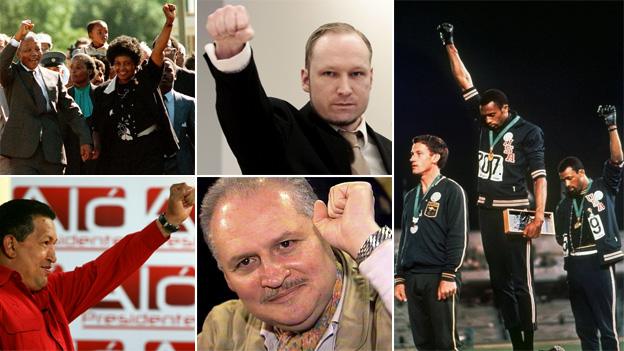Breivik: What's behind clenched-fist salutes?
- Published

The man who admits killing 77 people in Norway began his trial with a closed-fist salute. What's behind this gesture?
He smiled as the handcuffs were released.
Then Anders Behring Breivik clenched his right hand, held it to his chest and extended his arm to raise it above the Oslo court.
In the world's media, the motion was interpreted as a demonstration that the man who killed scores of people in gun and bomb attacks in July 2011 felt no remorse or repentance.
If Breivik's performance was widely seen as a further insult to the memories of his victims and their families, it is because he adopted the iconography of political struggle.
Above all, it called to mind the 1968 Olympics when US athletes Tommie Smith and John Carlos made raised-fist salutes from the podium in protest at American treatment of its black population.

Feminists used the symbol as part of a logo
Indeed, the gesture has a long history as a symbol of defiance and solidarity, commonly associated with both left-wing politics as well as the struggles of oppressed groups - most of them far removed from the politics expressed by Breivik in his manifesto.
Iconography based around the fist can regularly be seen in early propaganda by labour organisations, such as a famous <link> <caption>1917 propaganda cartoon</caption> <url href="http://ideologicalart.wordpress.com/labor-movement/labor-movement-gallery/iww-fist-in-solidarity-newspaper-1917-3/" platform="highweb"/> </link> by the <bold>Industrial Workers of the World,</bold> a revolutionary US trade union.
But it was the Spanish Civil War of 1936-39, when the Popular Front or anti-fascist salute was used as a greeting by Republican forces fighting Franco's Nationalists, which truly popularised it.
Though the Spanish Republicans were defeated, their salutation was adopted by left-wingers and opponents of fascism in Europe. To this day the clenched fist holding a rose remains the logo of the Socialist International, to which the UK Labour party is affiliated, as well as a number of European socialist parties including those in France and Spain.

Socialists, such as Tommy Sheridan, have used it for a long time
In turn, it was incorporated into the symbolism of a range of radical groups. These included the <bold>feminist movement,</bold> whose image of a fist inside the female gender symbol was popularised during protests against the <link> <caption>Miss America Beauty pageant.</caption> <url href="http://www.jofreeman.com/photos/MissAm1969.html" platform="highweb"/> </link>
During the 1960s, the black power salute emerged from militant offshoots of the US struggle for civil rights and groups like the Black Panther Party. Its use during the 1968 Olympics was seen as a nod to black power, although Tommie Smith insisted in his autobiography that he saw it as a "human rights salute".
Equally, however, the raised fist has come to be seen as a signifier of individual as well as collective defiance - as witnessed when Nelson Mandela was released from prison in 1990.
For psychologist Oliver James, author of Affluenza, the clenched fist has proved such a powerful symbol because it encapsulates connotations of resistance, solidarity, pride and militancy in one simple gesture.
"It's a way of indicating that you intend to meet malevolent, massive institutional force with force of your own - you are an individual who feels bound with other individuals to fight an oppressive status quo," James says.
Of course, not all uses of the raised fist are political - from the Northern Soul logo to tennis player Tim Henman's famous celebration.
But there are antecedents which put Breivik's adoption of the gesture in some kind of context.
He is not the first alleged political killer to use the gesture in a courtroom setting. Lee Harvey Oswald presented a raised fist to photographers after his arrest for the shooting of President John F Kennedy. Ilich Ramirez Sanchez - better known as Carlos the Jackal - famously made the same motion from the courtroom dock.

Sportsmen and women frequently use some sort of clenched-fist gesture
Breivik's straight arm calls to mind the "Roman salute" displayed by Benito Mussolini's fascists. Moreover, the <bold>White Power or Aryan fist </bold>has been adopted as a symbol of extremists, <link> <caption>according to the US-based Anti-Defamation League,</caption> <url href="http://www.adl.org/hate_symbols/racist_aryan_fist.asp" platform="highweb"/> </link> which monitors hate groups.
The Norwegian's own manifesto describes at length his salute and how it represents "strength, power and defiance against Marxist tyrants".
"It's not surprising if you put it in context of his manifesto," says Matthew Goodwin, a political scientist and expert in extremism at the University of Nottingham. "It comes down to notions of resistance and survival that are widespread on the European far right."
Nonetheless, for James, it is the 1968 Olympics protest that remain the most powerful and widely recognised example of the gesture - and he believes Breivik was inevitably channelling its iconography, whether he realised he was doing so or not.
"He's probably not doing it in a self-conscious way," James says. "He's doing it to conflate their legitimate complaint with his own."
That is a conflation that few in Norway and elsewhere are likely to accept.

Anti-fascist protesters doing the salute at a No to Hitler rally in Germany, 1935